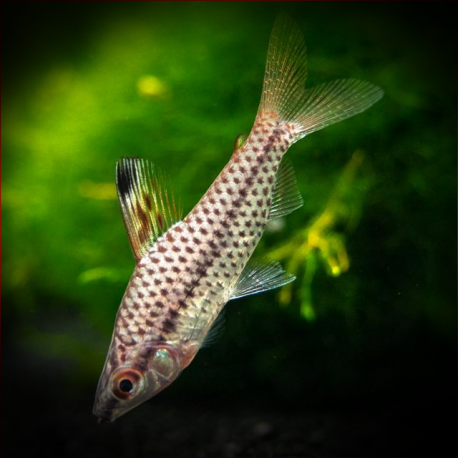More info
Datasheet
| Minimum Tank Size | 80 litres / 21.13 US gallons |
| Maximum Size | 8.0cm / 3.15inches |
| Temperature | 20°C / 68.00°F - 28°C / 82.40°F |
| Hardness | 1.01dgH / 18ppm - 10.03dgH / 179ppm |
| pH | 5.0-7.5 |
General Description
The Spotted Headstander, scientifically known as Chilodus Punctatus, is a species also called the "checkered headstander." It belongs to the order Characiformes and the family Chilodontidae. This species reaches a maximum size of about 8.0cm and is mainly found in slow-moving rivers, tributaries, oxbows, and floodplain lakes. Its color pattern may vary depending on the locality.
Aquarium Setup
For a Spotted Headstander, an aquarium setup should mimic its natural habitat. This includes a biotope-style arrangement with components such as a sandy substrate, driftwood roots, branches, leaf litter, and floating vegetation. Although they might browse algae, they should not consume leaves or soft shoots. It is crucial to maintain stable water conditions with a pH range of 5.0-7.5, hardness between 18-179ppm, and a temperature ranging from 20-28°C. Avoid introducing them to a biologically-immature aquarium to prevent issues related to dissolved organic wastes.
Behaviour
The Spotted Headstander is known to display relatively shy and peaceful behavior. They do not appreciate the presence of boisterous or fast-moving species in their tank. Compatible tankmates for this species include various tetras, smaller loricariids, Corydoras spp., and peaceful cichlids like Cleithracara or Mikrogeophagus spp. While they can be kept in a group, some squabbling may occur, but physical damage is rare as long as there is enough cover available in the tank.
Feeding and Diet
Being omnivorous, the Spotted Headstander accepts a wide variety of foods. In the wild, their diet consists mainly of insects and insect larvae such as Trichoptera, Hemiptera, and Homoptera orders, along with some terrestrial fruits and even fish scales. In an aquarium setting, they should be offered live foods like Daphnia, Artemia, Moina, bloodworms, as well as vegetable matter in the form of blanched spinach, lettuce, cucumber, fruits, algae wafers, and good-quality sinking dried foods.
Reproduction & Dimorphism
Although reproduction details are scarce, the Spotted Headstander is believed to be an egg scatterer without any parental care. They are known to spawn at the beginning of the wet season. In terms of sexual dimorphism, adult males typically develop a slightly more extended dorsal fin compared to females, while mature females tend to have a rounder overall shape than males.
Habitat and Distribution
The Spotted Headstander is described from Lake Amuku in the upper Essequibo River system in Guyana and is found across various regions in the Amazon system in Ecuador, Peru, and Brazil. Additionally, it inhabits the western Orinoco in Colombia, the Apeú drainage in Pará state, eastern Brazil, and several coastal river systems in Guyana and Suriname. The species thrives in slow-moving rivers, tributaries, oxbows, and floodplain lakes, preferring habitats with suitable vegetation and cover.

